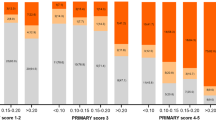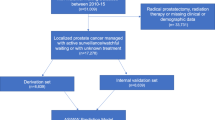Abstract
Background:
Previous studies have found persistent overuse of imaging for clinical staging of men with low-risk prostate cancer. We aimed to determine imaging trends in three cohorts of men.
Methods:
We analyzed imaging trends of men with prostate cancer who were a part of Cancer of the Prostate Strategic Urologic Research Endeavor (CaPSURE) (1998–2006), were insured by Medicare (1998–2006), or privately insured (Ingenix database, 2002–2006). The rates of computed tomography (CT), magnetic resonance imaging (MRI) and bone scan (BS) were determined and time trends were analyzed by linear regression. For men in CaPSURE, demographic and clinical predictors of test use were explored using a multivariable regression model.
Results:
Since 1998, there was a significant downward trend in BS (16%) use in the CaPSURE cohort (N=5156). There were slight downward trends (2.4 and 1.7%, respectively) in the use of CT and MRI. Among 54 322 Medicare patients, BS, CT and MRI use increased by 2.1, 10.8 and 2.2% and among 16 161 privately insured patients, use increased by 7.9, 8.9 and 3.7%, respectively. In CaPSURE, the use of any imaging test was greater in men with higher-risk disease. In addition, type of insurance and treatment affected the use of imaging tests in this population.
Conclusions:
There is widespread misuse of imaging tests in men with low-risk prostate cancer, particularly for CT. These findings highlight the need for examination of factors that drive decision making with respect to imaging in this setting.
This is a preview of subscription content, access via your institution
Access options

Similar content being viewed by others
References
O'Dowd GJ, Veltri RW, Orozco R, Miller MC, Oesterling JE . Update on the appropriate staging evaluation for newly diagnosed prostate cancer. J Urol 1997; 158 (3 Pt 1): 687–698.
Thompson I, Thrasher JB, Aus G, Burnett AL, Canby-Hagino ED, Cookson MS et al. Guideline for the management of clinically localized prostate cancer: 2007 update. J Urol 2007; 177: 2106–2131.
Greene KL, Albertsen PC, Babaian RJ, Carter HB, Gann PH, Han M et al. Prostate specific antigen best practice statement: 2009 update. J Urol 2009; 182: 2232–2241.
Heidenreich A, Bellmunt J, Bolla M, Joniau S, Mason M, Matveev V et al. EAU guidelines on prostate cancer. Part 1: screening, diagnosis, and treatment of clinically localised disease. Eur Urol 2011; 59: 61–71.
Mohler JL . The 2010 NCCN clinical practice guidelines in oncology on prostate cancer. J Natl Compr Canc Netw 2010; 8: 145.
Cooperberg MR, Lubeck DP, Mehta SS, Carroll PR . Time trends in clinical risk stratification for prostate cancer: implications for outcomes (data from CaPSURE). J Urol 2003; 170 (6 Pt 2): S21–S25 discussion S6-7.
Dong F, Reuther AM, Magi-Galluzzi C, Zhou M, Kupelian PA, Klein EA . Pathologic stage migration has slowed in the late PSA era. Urology 2007; 70: 839–842.
Cooperberg MR, Lubeck DP, Grossfeld GD, Mehta SS, Carroll PR . Contemporary trends in imaging test utilization for prostate cancer staging: data from the cancer of the prostate strategic urologic research endeavor. J Urol 2002; 168: 491–495.
Chamie K et al. Bone scan use in the staging of prostate cancer: an analysis of a Veterans Affairs cohort. Urology 2014; in press.
Miller DC, Hafez KS, Stewart A, Montie JE, Wei JT . Prostate carcinoma presentation, diagnosis, and staging: an update form the National Cancer Data Base. Cancer 2003; 98: 1169–1178.
Lavery HJ, Brajtbord JS, Levinson AW, Nabizada-Pace F, Pollard ME, Samadi DB . Unnecessary imaging for the staging of low-risk prostate cancer is common. Urology 2011; 77: 274–279.
Choi WW, Williams SB, Gu X, Lipsitz SR, Nguyen PL, Hu JC . Overuse of imaging for staging low risk prostate cancer. J Urol 2011; 185: 1645–1649.
Dinan MA, Curtis LH, Hammill BG, Patz EF Jr, Abernethy AP, Shea AM et al. Changes in the use and costs of diagnostic imaging among Medicare beneficiaries with cancer, 1999-2006. JAMA 2010; 303: 1625–1631.
Fazel R, Krumholz HM, Wang Y, Ross JS, Chen J, Ting HH et al. Exposure to low-dose ionizing radiation from medical imaging procedures. N Engl J Med 2009; 361: 849–857.
Smith-Bindman R, Lipson J, Marcus R, Kim KP, Mahesh M, Gould R et al. Radiation dose associated with common computed tomography examinations and the associated lifetime attributable risk of cancer. Arch Intern Med 2009; 169: 2078–2086.
Lubeck DP, Litwin MS, Henning JM, Stier DM, Mazonson P, Fisk R et al. The CaPSURE database: a methodology for clinical practice and research in prostate cancer. CaPSURE Research Panel. Cancer of the Prostate Strategic Urologic Research Endeavor. Urology 1996; 48: 773–777.
Cooperberg MR, Broering JM, Carroll PR . Risk assessment for prostate cancer metastasis and mortality at the time of diagnosis. J Natl Cancer Inst 2009; 101: 878–887.
Jemal A, Siegel R, Xu J, Ward E . Cancer statistics. CA Cancer J Clin 2010; 60: 277–300.
Oesterling JE . Using PSA to eliminate the staging radionuclide bone scan. Significant economic implications. Urol Clin North Am 1993; 20: 705–711.
Abuzallouf S, Dayes I, Lukka H . Baseline staging of newly diagnosed prostate cancer: a summary of the literature. J Urol 2004; 171 (6 Pt 1): 2122–2127.
Briganti A, Passoni N, Ferrari M, Capitanio U, Suardi N, Gallina A et al. When to perform bone scan in patients with newly diagnosed prostate cancer: external validation of the currently available guidelines and proposal of a novel risk stratification tool. Eur Urol 2010; 57: 551–558.
Levran Z, Gonzalez JA, Diokno AC, Jafri SZ, Steinert BW . Are pelvic computed tomography, bone scan and pelvic lymphadenectomy necessary in the staging of prostatic cancer? Br J Urol 1995; 75: 778–781.
Cooperberg MR, Pasta DJ, Elkin EP, Litwin MS, Latini DM, Du Chane J et al. The University of California, San Francisco Cancer of the Prostate Risk Assessment score: a straightforward and reliable preoperative predictor of disease recurrence after radical prostatectomy. J Urol 2005; 173: 1938–1942.
Reckwitz T, Potter SR, Partin AW . Prediction of locoregional extension and metastatic disease in prostate cancer: a review. World J Urol 2000; 18: 165–172.
Brajtbord JS, Lavery HJ, Nabizada-Pace F, Senaratne P, Samadi DB . Endorectal magnetic resonance imaging has limited clinical ability to preoperatively predict pT3 prostate cancer. BJU Int 2011; 107: 1419–1424.
Rorvik J, Halvorsen OJ, Albrektsen G, Ersland L, Daehlin L, Haukaas S. MRI . with an endorectal coil for staging of clinically localised prostate cancer prior to radical prostatectomy. Eur Radiol 1999; 9: 29–34.
Palvolgyi R, Daskivich TJ, Chamie K, Kwan L, Litwin MS . Bone scan overuse in staging of prostate cancer: an analysis of a Veterans Affairs cohort. Urology 2011; 77: 1330–1336.
Prasad SM, Gu X, Lipsitz SR, Nguyen PL, Hu JC . Inappropriate utilization of radiographic imaging in men with newly diagnosed prostate cancer in the United States. Cancer 2012; 118: 1260–1267.
Kindrick AV, Grossfeld GD, Stier DM, Flanders SC, Henning JM, Carroll PR . Use of imaging tests for staging newly diagnosed prostate cancer: trends from the CaPSURE database. J Urol 1998; 160 (6 Pt 1): 2102–2106.
Hollingsworth JM, Birkmeyer JD, Zhang YS, Zhang L, Hollenbeck BK . Imaging use among employed and self-employed urologists. J Urol 2010; 184: 2480–2484.
Services. CfMaM. PQRI Measures List, 2010; available from https://www.cms.gov/PQRI/Downloads/2010PQRIMeasuresList111309.pdf. (accessed 20 January 2011).
Miller DC, Murtagh DS, Suh RS, Knapp PM, Schuster TG, Dunn RL et al. Regional collaboration to improve radiographic staging practices among men with early stage prostate cancer. J Urol 2011; 186: 844–849.
Acknowledgements
This study was funded by Urologic Diseases of America Project.
Author information
Authors and Affiliations
Consortia
Corresponding author
Ethics declarations
Competing interests
The authors declare no conflict of interest.
Rights and permissions
About this article
Cite this article
Porten, S., Smith, A., Odisho, A. et al. Updated trends in imaging use in men diagnosed with prostate cancer. Prostate Cancer Prostatic Dis 17, 246–251 (2014). https://doi.org/10.1038/pcan.2014.19
Received:
Revised:
Accepted:
Published:
Issue Date:
DOI: https://doi.org/10.1038/pcan.2014.19
This article is cited by
-
Molecular alterations in prostate cancer and association with MRI features
Prostate Cancer and Prostatic Diseases (2017)



